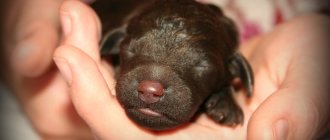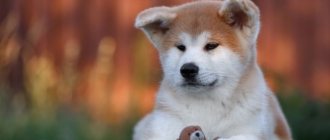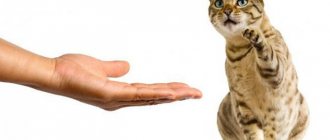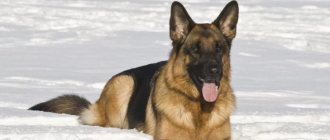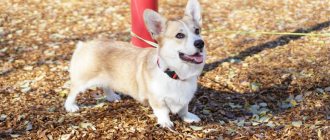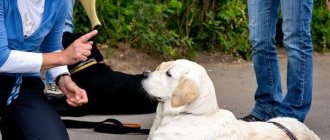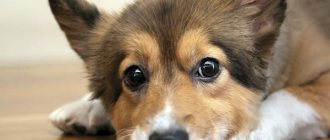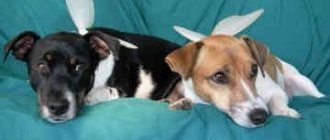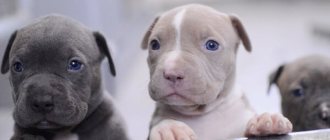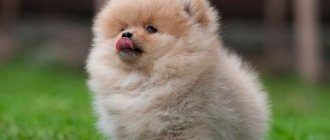The general training course (abbreviated OKD) is a dog training program developed by the domestic dog handler Vsevolod Vasilievich Yazykov in the 1920s. Since that time, the course has remained virtually unchanged, only occasional amendments have been made.
Any dog needs some form of general training. In the process of training, the animal develops obedience and a number of other useful skills that are useful both in everyday life and in professional activities. In most cases, dogs that have not passed the OKD are not allowed to participate in other types of training.
To complete a general dog training course, you can enroll in classes at a local dog training school or contact a private specialist. You can also train your pet on your own, but in this case you will need to find a suitable site, carefully read the rules and regulations for OKD, find out the dates of exams and agree with the instructor.
Let's look at which teams are included in the OKD exam and how to pass the tests successfully.
Preparation for OKD
It is recommended to train your dog 2 times a day before feeding .
The duration of each workout should be no more than 2 hours .
over the age of 12 months are allowed to take the OKD exam .
For the exam, the dog must know the basic commands “Sit”, “Lie down”, “Come to me”, etc.
The number of commands studied in one lesson depends on the preparation of the animal and its level of performance. Usually at first it is enough to study and repeat 2 commands, in the future their number should be increased.
Grades, degrees, differences
First of all, OKD has two standards: test and competition. Dogs over one year old, of any breed and size, are allowed to take part in the tests. The overall impression and quality of control of the dog when performing various elements are assessed. The dog should not show cowardly or aggressive behavior, and calmly and joyfully do what the handler orders from the first command.
The final degree depends on how many points you receive. It determines the level of training. The largest number is one hundred points, the smallest is sixty.
- from 90 to 100 - first degree
- from 70 to 89 - second degree
- from 60 to 79 - third degree
A dog with less than sixty points is considered to have failed the test. But even if such a nuisance happened, this is not a reason to panic: the OKD can be taken again, but not earlier than in a month.
Those for whom everything went well are given a diploma certified by the RKF and a token, and in the pedigree of the descendants they indicate the name of the discipline completed by the parent, indicating the assigned degree.
Only those tailed animals that have successfully passed the tests can participate in OKD competitions. This standard is slightly different from the previous one, and the work is assessed in two tests: personal and team. For those who are small in stature (42 cm or less), they came up with a mini-OKD, in which everything was adapted to their characteristics.
The winners receive medals and cups, they are also given diplomas and tokens.
What does the exam include?
during the general training course exam :
- movement of the dog next to the owner (assessed throughout the entire test period);
- display of teeth and the dog's attitude towards the muzzle;
- a set of commands “Sit”, “Lie down”, “Stand”;
- the dog’s approach to the owner and return to the place;
- aportation;
- stopping unwanted actions (command “Fu”, refusal to take food from a stranger);
- overcoming a set of obstacles (barrier, stairs, boom, fence or inclined wall);
- attitude towards the shot.
Skill testing can be carried out in any order, with the exception of commands running as a complex.
Minimum score table
Based on the results of passing the OKD for dogs, diplomas of various degrees are issued (or the exam is not counted):
| Skill | Evaluation of the dog's performance | |||
| Highest score – 100 points | Diploma 1 – 90 points | Diploma 2 – 80 points | Diploma 3 – 60 points | |
| "Near" | 10 | 9 | 8 | 6 |
| "To me" | 10 | 9 | 8 | 6 |
| "Place" | 10 | 9 | 8 | 6 |
| Complex commands | 10 | 9 | 8 | 6 |
| Importation | 10 | 9 | 8 | 6 |
| Prohibition of taking food and objects | 10 | 9 | 8 | 6 |
| Reaction to the sound of a gunshot | 10 | 9 | 8 | 6 |
| "Show your teeth" | 10 | 9 | 8 | 6 |
| Overcoming obstacles | 10 | 9 | 8 | 6 |
| Dog activity, general impression | 10 | 9 | 8 | 6 |
For each skill you can get a maximum of 10 points, penalties for performing each of the commands are prescribed in the OKD standards.
Team “Nearby”
On the command “Near”, the dog must walk to the left of the owner so that its shoulder is at the level of his leg.
You can find out how to teach this command by reading a separate article on our website - How to teach a dog the “Near” command.
How is a skill tested in the exam? The trainer gives the command “Nearby” with his voice, and then, at the judge’s signal, makes turns on the spot: right, left, around. Next comes the movement, during which the judge checks the dog’s work when changing the pace and direction of walking, as well as when stopping. The animal should walk calmly, and during stops sit at the owner’s left leg without the command “Sit”.
If the dog deviates to the side by more than 2 m, refuses to sit down, or does not make turns, then the judge does not count the skill.
Canine group "Fortuna"
OKD (general training course)
I. Competition participants
1.1 Conditions for admission of athletes. Athletes at least 12 years of age have the right to take part in competitions. To participate in sports competitions, the athlete must turn the specified number of years before the start of the competition.
1.2 Conditions for the admission of dogs. All dogs are allowed to participate in the competition, regardless of their size, breed and pedigree. The minimum age of dogs is 15 months (determined on the day of the competition). To participate in competitions, a dog must have a test diploma in OKD of any degree. Before the start of the competition, a veterinary examination of the dogs is carried out outside the competition area. Dogs are allowed to compete if they have a veterinary document indicating the full date of birth, brand and (or) microchip, and rabies vaccination mark. Dogs with infectious diseases, mange, hookworms or other parasites, blind or deaf dogs cannot compete. Females in heat are allowed to participate, but must compete last. They must be kept away from the competition area until the other dogs have finished competing. Bitches who gave birth less than 8 weeks before the competition, as well as bitches expecting puppies within the next four weeks, are not allowed to participate. If necessary, the judge may check the dog outside the competition area before the start of the competition. In the ring during work, dogs are only wearing soft collars or chains, without medals or tags. To ensure the safety of participants and spectators, all dogs outside the rings must be on a leash and muzzled.
II. Venue of the competition
2.1 Size of the ring for performances. The competition location must be clearly marked (by any means) and divided into rings. The rings must also be clearly marked. The number of rings, and the order of their arrangement, the order of the arrangement of the projectiles is determined by the main panel of judges. The size of the ring must be at least 20m. X 30m. The competition venue must be equipped with standard equipment, the number of sports equipment, and their location is determined by the main panel of judges. Before the start of the competition, the main panel of judges inspects the competition venue and signs a standard report on the compliance of the presented equipment with the requirements of the OKD standard, and also inspects the rings for the presence of the necessary markings.
2.2 Equipment The Main Judicial Panel must have: a copy of the rules at the competition venue, a stopwatch and a starting pistol with ammunition in the required quantity, an equipped workplace for the Main Judicial Panel (table, chairs). A set of 6 pieces of equipment: a ladder, an athletics barrier, a trench, a slide, a barrier, a boom. Appropriate items for fetching: Two sets of wooden dumbbells of different sizes and weights for different breeds. Each set includes two dumbbells. The maximum weight of the dumbbell included in the kit is 650g, the minimum is 250g. The athlete has the right to choose.
III. Order of conduct
3.1 Draw Only those athletes whose applications are accepted by the organizing committee of the competition before the registration deadline take part in the draw. The draw is made by the organizing committee after the end of accepting applications in the presence of team representatives, before the start of the competition (no later than 1 hour before the start).
3.2 Order of sections The sequence of performing exercises is determined by the main panel of judges of the competition. The established procedure must be observed by all participants in the competition.
IV. Grade
4.1 Judging Criteria Judges appointed to participate in competitions must have the appropriate categories. A judge may not enter dogs registered in his name or members of his family into competitions where he judges. A judge may not judge a dog that he has owned, kept, leased or sold less than 6 months before the competition. The same applies to dogs owned by family members. It is prohibited to smoke or drink alcoholic beverages during judging. It is forbidden to travel to competitions where he judges with participants. It is prohibited to communicate with any participant, stay in his home or in his custody until the end of the event. It is recommended that the judge judge no more than 10 dogs per hour and no more than 60 per day. If more than one judge is appointed, each judge judges the exercises selected for him/her for all dogs entered in the competition.
4.2 Judges in the ring. If exercises are held in two or more rings in addition to the Chief Judge of the competition, Senior Judges are appointed in each ring. Each ring can have a panel of up to 3 judges. The judges in the ring follow the instructions of the Chief Judge and monitor the actions of the athlete and the dog. The Chief Judge directs the actions of the Senior Judges in the rings. The decision of the Chief Judge of the competition is final. Before the start of the competition, the Chief Judge and the ring judges conduct a judging seminar regarding the judging criteria for all exercises included in the competition program. Decisions made at the seminar must be communicated to the competition organizing committee and team representatives (no later than an hour before the start of the competition).
4.3 Management of the competition The competition is held under the leadership of the Chief Judge with the assistance of the organizing committee. In the event of any incident that does not fall within the accepted norms and instructions, the judge in the ring, together with the main panel of judges and the organizing committee, decides on the methods of continuing the competition or on the assessment of such an incident.
4.4 Permitted and prohibited actions The athlete’s responsibilities begin the moment he enters the competition area and end after the award ceremony. The athlete must follow the rules and instructions. He must behave with dignity and be dressed appropriately. When performing all exercises, each athlete must have a sports number with clear numbers (the height of the numbers is not less than 20cm), which is attached to the back or chest over the uniform in which he or she is competing. The judge may remove the athlete from the competition if he or she does not comply with the rules of the competition or behaves inappropriately. The judge's decision is final and the athlete cannot challenge it. It is forbidden to punish the dog. Prong collars and electric collars are prohibited. The dog must be to the athlete's left during and between exercises. If there is a physical reason or deficiency of the athlete, the dog is allowed to be on the athlete's right side during or between exercises. The athlete or the captain of the team that has such an athlete must discuss this with the head judge before the start of the competition. All judges concerned must be informed. Changes in the exercise pattern must be approved and must not interfere with other athletes and dogs.
4.5 Dog Behavior / Disqualification If a dog, even after completing the competition, tries to bite, attacks or attempts to attack a person or dog, it is disqualified from the competition. All her points are reset to zero, even if she has already finished the performance. In two-day competitions, the disqualification is valid for both days. Information about disqualification is entered into the dog’s work book, and a report about it is sent to the club that the dog represents.
4.6 Other Regulations When the ring is being prepared or has already been prepared for competition, the competitor may enter the ring with the dog only with the permission of the Chief Judge in the ring.
4.7 General provisions and guidelines for the performance and evaluation of competitive exercises. Unless otherwise stated in the individual routine descriptions, these general guidelines for performing and judging routines apply to all routines. If an incident occurs that is not covered by these rules, the Chief Referee will decide how to evaluate and resolve it. The Chief Judge's decision is final and the athlete cannot challenge it.
4.8 Points awarded. At competitions, the overall assessment of the athlete’s performance is formed on the basis of the final table of penalty points. The penalty points accumulated by the athlete are deducted from the maximum score of his work - 50 points. An athlete's performance only counts when two or more dogs have exactly the same scores: equal amounts for each skill. The dog's performance is assessed by the judge in accordance with a table of penalty points for each skill. For incorrect and unclear actions, penalty points are deducted from the highest score for the skill. If an athlete demonstrates any exercise with a score below the minimum, then he is removed from the competition with the loss of all points and cannot continue to perform the remaining exercises. All actions of the athlete that distort or supplement the normative command when the dog demonstrates a skill (complex) and affect its work are assessed as additional influences on the dog and are fined, each separately under the item “other violations” of this skill in the evaluation sheet. The minimum fine for all points in the score sheet, except for the “other violations” point, -1 point only for the “other violations” point; the fine is awarded from 0.5 to 2 points with a gradation of 0.5 points (0.5; 1; 1.5; 2)
4.9 Performing exercises The sequence of exercises is agreed upon in advance (before the start of the competition) and must be the same for all athletes.
According to the general training course, the following exercises are demonstrated: 1. Demonstration of the dental system, attitude towards the muzzle, transition to a free state. 2. Attitude towards food, prohibiting command “Fu”. 3. Apportation (tray of an object). 4. Place (being in place, returning to place on command). 5. Approach to the athlete (on command). 6. Stand, landing, laying (checked as a whole). 7. The movement of the dog next to the athlete. 8. Overcoming obstacles. 9. Controllability of the dog when shooting.
By decision of the main panel of judges of the competition, the following skills: “showing the dental system”, “attitude towards the muzzle”, “transition to a free state”, “prohibiting command “Fu” - may not be tested at the corresponding competition, and the maximum points for performing these skills are automatically added to the final mark that is awarded to the dog at this competition, as well as: when checking the “Place” skill, the main panel of judges of the competition can itself provide a common object to indicate “place”, which is the same for all dogs at this competition. The competition begins with a report. The athlete with the dog approaches the judge and stops 2-3 meters from him, introduces himself and clearly reports his readiness for the competition. The exercises begin and end in the athlete’s main position (the dog sits parallel to the athlete’s left leg, without leaning on its side). All actions of the athlete in the ring are controlled by the judge. The athlete independently controls the dog only if it gets out of his control and/or leaves the ring. In this case, she is removed from the competition. Before demonstrating the exercise, the athlete must leave the leash outside the ring or on the table of the refereeing team. All exercises begin after, at the direction of the judge, the athlete with the dog takes the starting position at the pre-designated starting point in the desired position. The judge informs the athlete about the end of judging of each skill. After demonstrating each exercise, the trainer is allowed to stroke the dog, as well as encourage it with his voice. Rewarding with treats and playing with the dog between demonstrations of skills is not allowed. The competitor is not allowed to touch, pet or otherwise encourage the dog during the exercise. Picking up a dog by the collar in the ring is not allowed. Testing of equipment is permitted before the start of the competition. The athlete must give a command by voice, gesture or voice and gesture immediately after the referee’s instruction. You are allowed to influence the dog's behavior for 3 seconds. The athlete moves with an energetic step when demonstrating exercises.
4.10 Assessing the quality of the exercise Judging the exercise begins from the moment the athlete enters the ring. Judging ends when the judge announces “The routine is over.” All additional commands, additional body pressure, etc. are fined on the score sheet. If the dog does not comply with any given command after 2 repetitions, or does not come to the command, and also defecates during or between exercises, then it is removed from the competition.
V. CHECKING THE EXECUTION OF COMMANDS: EXECUTION AND EVALUATION CRITERIA
Exercise No. 1
Demonstration of the dental system, attitude towards the muzzle, transition to a free state Voice commands: “Next”, “Sit”, “Walk”, “Come to me”; gesture with the right hand (checked as a whole). Performance:
At the direction of the judge: • the athlete with the dog approaches the judge and stops; • shows the dog’s dental system, puts a muzzle on the dog • puts the dog in a free state with the command “Walk” (not towards the judge); • starts moving • calls the dog • removes its muzzle.
Before showing the dental system and putting on the muzzle, the fixing command “Sit” is penalized as a repeated command. Evaluation of the exercise: The dog should not resist when showing the dental system, treat the muzzle calmly, not show anxiety when putting it on, and when the athlete gives the “Walk” command, move to a free position. At the direction of the referee, the athlete may move in any direction, but not towards the referee. When calling a dog, the athlete is allowed to give the name once, then giving the name is penalized under the item “Other violations” - 1 point.
| penalty points | |
| resistance when showing the dental system | 1 |
| resistance when putting on the muzzle | 1 |
| every attempt to throw off the muzzle | 1 |
| every repeated command | 1 |
| every mechanical impact on the dog | 1 |
| other violations | 0,5-2 (0,5; 1; 1,5; 2) |
Failure to perform the skill of “showing the dental system” is considered to be the inability to examine the dog’s dental system. Failure to comply with the “attitude to the muzzle” skill is throwing off the muzzle, or continuous attempts to throw it off, despite the athlete’s commands, or the inability to put the muzzle on the dog. Failure to change the position of the dog after the command “Walk” is fined under the paragraph “Other violations”
Exercise No. 2.
Attitude towards food, prohibiting command “Fu” The skill is tested in two stages. The first stage of the voice command: “Walk” and a gesture with the right hand. Execution: The skill is tested on a 3m area. x 4 m., where the assistant scatters several noticeable pieces of attractive food (treats) in advance. The judge must know the number of pieces thrown. An athlete with a dog without a leash, on the instructions of the judge, approaches the area where the food is scattered, stops 2 meters from the area, commands “Walk” and with a gesture sends the dog to this area and continues to move in the direction of the food together with the dog. According to the judge’s instructions, after passing the area with the treat, the athlete calls the dog with the command “Come to me.” Giving the prohibiting command “Fu” is not allowed. By decision of the main panel of judges, the Feeding skill on the ground can be combined with the test of any other skill (except for overcoming obstacles and fetching).
Second phase. Command: "Ugh." Execution: At this stage, the skill is checked (after preliminary agreement with the athlete) in one of the following ways: • prohibiting the dog from taking food from the athlete’s hands; • prohibition to take any item. In the first method, at the direction of the judge, the athlete performs the following actions: • approaches the judge and stops in front of him; • with his hand (on an open palm, silently) gives one piece of treat several times; • when giving the next piece, gives the command “Fu”; • after holding for up to 5 seconds. removes the hand with the treat. • resumes giving treats. In the second method, the athlete sends the dog to retrieve the object he threw. Then, at the direction of the judge, he gives the command “Fu”, according to which the dog must throw the object out of its mouth. Repeated "Fu" commands are not allowed. No more than two commands are allowed to resume a skill.
Exercise score (5-2 points)
| penalty points | |
| Attitude to food | |
| Prohibiting command "Fu" | |
| failure to resume eating food after two permissive commands | 1 |
| not resuming importation after two enabling commands | 1 |
| other violations | 0,5-2 (0,5; 1; 1,5; 2) |
Failure to perform the skill “Relation to food” is taking food into the mouth. The “Prohibitory command - Fu” skill is considered failed if the dog takes food into its mouth after the prohibitory command or does not throw away the object after the prohibitory command.
Exercise No. 3 Apportation (traying an object)
Voice commands: “Nearby”, “Fetch”, “Give”; right hand gesture. Performance:
As directed by the judge: • the athlete takes and shows the dog the retrieving object. For all participating dogs, a single sample item weighing from 250 to 650 grams is used. (The athlete has the right to choose the subject); • throws an object no closer than 10 meters from oneself; • simultaneously sends the dog after the object with the command “Fetch” and with a gesture; • after bringing the object and waiting for up to 5 seconds, on the command “Give” he takes the object from the dog.
The fixing command “Sit” before throwing the apportion object is penalized. The dog must run up to the thrown object, take it in its mouth and return to the athlete equally quickly. Sit with the object at your left leg (the dog is allowed to sit in front of the athlete). If the dog sits in front of the athlete, the latter, on the instructions of the judge, takes the object from the dog and independently gives the command “Nearby”, after which the dog must sit next to the athlete’s left leg (after the command “Nearby”, walking around is not necessary).
Skill score (13-8 points)
| penalty points | |
| every repeated command | 1 |
| lack of endurance | 2 |
| throws an object near the trainer within 1 m. | 2 |
| playing with an object | 1-3 |
| slow movement towards the aportable object | 1-2 |
| slow movement towards the trainer | 1-2 |
| incorrect landing, loose passing of the trainer | 1 |
| no landing | 2 |
| recoil resistance | 2 |
| other violations | 0,5-2 (0,5; 1; 1,5; 2) |
Exercise No. 4 “Place”
Voice commands: “Place”, “Lie down”, “Come to me”, “Sit” or “Nearby”, gesture with the right hand. Performance:
According to the judge's instructions: • athlete: puts the dog down with the command “Down”; • places near the dog’s elbow and gives the command “Place” (an object to indicate “place” can be provided by the Main Jury of the competition); • moves away from it by 25 meters. • after holding for at least 15 seconds , calls the dog with the command “Come to me” and/or with a gesture. The endurance is counted from the moment the athlete leaves the dog. • after the dog approaches and holds for up to 5 seconds, the athlete sends the dog to the place with the voice command “Place” or with voice and gesture (simultaneously). • after holding for up to 15 seconds , approaches the dog (the holding time is counted from the moment the dog enters a meter-long area around the place); • sits the dog down with the command “Sit” or “Next”; • picks up the item. The dog, on the first command, must quickly run up to the athlete in a straight line, and then, also on the first command, at the same pace return to the designated “place” and take the starting position without falling on its side , close to the object indicating the “place”.
Skill score (12-6 points)
| penalty points | |
| every repeated command | 1 |
| every lack of endurance | 2 |
| loose placement around the object | 1-2 |
| incorrect styling (falls on its side) | 1 |
| change of position | 1 |
| slow movement towards the athlete | 1-2 |
| slow movement towards the "place" | 1-2 |
| stop-and-go traffic | 1-3 |
| incorrect landing, loose passing of the athlete | 1 |
| no landing | 2 |
| other violations | 0,5-2 (0,5; 1; 1,5; 2) |
The skill is considered failed if the dog does not fulfill any standard command after 2 repetitions or does not assume a “lying” position in an area with a radius of 1 m. from the subject.
Exercise No. 5 “Approach to an athlete”
Voice command: “Come to me” and/or right hand gesture. Execution: The athlete calls the dog to him with the command “Come to me” and/or with a gesture. On the first command, the dog must quickly run up to the athlete in a straight line and sit at his left leg. When the dog approaches, it is allowed to sit in front of the athlete, after which, on the command “Near”, it must sit at the athlete’s left leg (walking around is not necessary). When calling a dog from a free state, after the command “Walk” before the command “Come”, you are allowed to use the name once, without reducing the score. Repeated use of a dog's name is fined under the “other violations” clause.
Skill score (13-9 points)
| penalty points | |
| every repeated command | 1 |
| every wrong landing | 1 |
| no landing | 2 |
| slow approach | 1-2 |
| stopover approach | 1-3 |
| loose walk around the athlete | 1 |
| other violations | 0,5-2 (0,5; 1; 1,5; 2) |
The skill is considered failed if the dog does not approach the athlete within 15 seconds after the first command given. No more than two repeated commands are allowed.
Exercise No. 6 “Stand”, “landing”, “laying” (tested in combination)
Voice commands: “Lie down”, “Sit”, “Stand” or a corresponding gesture with the right hand. Performance:
As directed by the judge: • the athlete fixes the dog in the position indicated by the judge; • moves away from it by 25 meters; • changes its position with commands (voice and gesture separately); • approaches the dog.
Each skill must be performed by the dog from different positions twice. The dog must, at the first command, take the required position and not change it. If the dog changes position, the athlete must return it to the required position independently with a second command.
Skill score (20-13 points)
| penalty points | |
| every repeated command | 1 |
| movement of more than 1 m. | 3 |
| movement of more than 2m. | 5 |
| every wrong position | 1 |
| other violations | 0,5-2 (0,5; 1; 1,5; 2) |
Failure to perform the “complex” skill is considered to be the dog advancing more than 3 meters in all techniques, as well as if the dog did not take the desired position after two repeated commands when moving from one position to another.
Exercise No. 7 “Movement of the dog next to the athlete.”
Voice command: “Nearby.” Execution: Giving the “Nearby” command is allowed only at the beginning of movement and when changing direction. The route of movement is determined by the main panel of judges of the competition. As directed by the judge: The athlete with the dog makes turns on the spot (right, left, around). Then he begins to move along a route of at least 30-40 steps in both directions. On the route, at the judge’s signal, the athlete changes the pace of movement (running, slow step, normal step) and direction of movement. The route scheme is established by the Ground Jury and must be the same for all athletes. The dog should walk closely and easily next to the athlete, without crowding him, at his left leg (dog's shoulder at knee level), maintaining the correct position at different speeds and when turning. When stopping, he sits down on his own at the athlete’s left leg, parallel to him, without falling over.
Skill score (18-10 points)
| penalty points | |
| every repeated command | 1 |
| every deviation within the body in any direction | 1 |
| every lack of landing | 2 |
| every wrong landing | 1 |
| every mechanical impact | 2 |
| every time the dog runs ahead of the athlete or lags behind with the appearance of a gap between the dog and the athlete | 2 |
| each deviation of the dog with the appearance of a gap equal to the length of the dog’s body | 3 |
| other violations | 0,5-2 (0,5; 1; 1,5; 2) |
The skill is considered not completed if the dog deviates in any direction by more than the length of the body (the appearance of a gap between the athlete and the dog is more than the length of the body).
Exercise No. 8 “Overcoming obstacles”
Obstacles: blind fence – 180cm; slide – 180cm; rigidly fixed track and field hurdle – 75cm; boom; ladder; breaking bridge (trench). All running surfaces of projectiles must have a non-slip coating. Voice commands: “Forward”, “Barrier”, “Come to me”, “Nearby”; right hand gesture. Obstacles are divided into 3 groups: 1st group - vaults: a blind fence 180cm high, a slide 180cm high; 2nd group – unsupported jumps: breaking bridge, rigidly fixed, athletics barrier 75 cm high; 3rd group - movement along the projectile: boom, stairs. The number and order of overcoming obstacles on the route is determined by the main panel of judges. Moreover, among the selected obstacles there must be at least one from each group. Overcoming all these obstacles is mandatory. Only one repeated attempt to overcome each obstacle is allowed.
Execution: Execution begins after the athlete is announced the route of movement and the sequence of overcoming obstacles. At the direction of the judge, the athlete begins to move along the route and stops in a 3-meter zone in front of the obstacle, using his voice and gesture to send the dog towards the obstacle. When overcoming a boom, a ladder, or an explosive bridge, the athlete follows along the apparatus behind the dog or next to it. When overcoming a blind fence, a slide and an athletics hurdle, the athlete can go around the apparatus only after the dog lands on the ground with all four paws. After the dog has overcome an obstacle, the athlete, going around it on the right side, can immediately begin moving with it using the command “Next” to the next obstacle , or, before starting the movement, use the command “Come to me” (the dog is required to sit at the athlete’s left leg). The dog must overcome the track and field hurdle with an unsupported jump - without touching it. At the boom, the dog enters the ladder, quickly walks along the boom and goes down the ladder on the other side. The dog goes up the stairs from one side and goes down the other without delay. The dog overcomes the breaking bridge (trench) by climbing onto its high platform along the ladder, and immediately jumps onto the low one, then goes down the ladder without delay. It is not allowed to provide the dog with any mechanical assistance when overcoming obstacles.
Overall score for overcoming obstacles (14-10 points)
| penalty points | |
| every repeated command | 1 |
| movement without command | 1 |
| touching the barrier with paws | 1 |
| slow movement (over an obstacle) | 1 |
| every retry | 1 |
| each athlete outpacing the dog | 1 |
| other violations | 0,5-2 (0,5; 1; 1,5; 2) |
Exercise No. 9 “Dog controllability when shooting”
The dog's controllability when shooting is checked when it performs any skill according to the decision of Chapter. of the panel of judges, in addition to the skills: • “Attitude towards food”; • “Overcoming obstacles” at the moment of overcoming projectiles; • “Apportation” at the moment of taking an object into the mouth. • The skill, which tests the dog's controllability during the shot, is established by the judge and applies to all dogs in the event. The controllability of the dog when firing is checked immediately during the process of performing the skill (without repeating it). According to the judge's instructions, a shot is fired from the starting pistol at a distance of 15 m from the dog, unnoticed by it. If the dog stops performing the skill after the shot, the athlete continues to control the dog independently. A score for the dog's behavior when shooting is not awarded separately. The shot itself is considered as a complication of the skill and is included in the overall score according to the table of penalty points for the skill being tested.
VI. Applications
Marking in the ring for a comprehensive test of skills “sit”, “lie down”, “stand”
Marking in the ring for testing the “place” skill
Description of designs of equipment for competitions and tests according to the General Training Course (GTC)
Athletics hurdle. Height - 75 cm. Width - 100 cm.
Sloping wall. Height -160\180cm. Width -150cm. The inclined wall consists of two panels 1.5m wide. and 2m high, which make up the upper parts. The inclined wall must have transverse strips with a cross-section of 20 mm. x 15mm. at a distance of 20cm. from each other, starting from the top.
Boom. The obstacle consists of a 500 cm long log with a flat top and two ladders. The height above the ground is 100 cm. The width of the flat part of the log and ladders is 20 cm. Cross bars with a cross-section of 4 cm x 4 cm are placed on the upper surface of the ladders at a distance of 20 cm from one another, starting from the top.
Pass-through staircase. The height of the platform above the ground is 300 cm, the size of the upper platform is 100 cm x 100 cm. The flight of stairs is installed at an angle of 450 to the ground, the width of the steps is 20 cm, the vertical height between steps is 25 cm. On the right side of the flight of stairs, at a height of 100 cm from the steps, a railing is installed. The horizontal projection length of the staircase is 700 cm.
LIST of commands used in OKD and ZKS competitions, and a description of the corresponding gestures
All gestures are given at the same pace without intermittent movements. Hold the gesture for no more than 3 seconds.
| No. | skills, teams | Gestures |
| 1 | The movement of the dog next to the trainer. Command "Near!" | Apply without gesture |
| 2 | Free state Command “Walk!” | Quickly raise your right hand, palm down, to shoulder height in the direction of the desired movement of the dog and lower it to the thigh of the right leg |
| 3 | The dog approaches the trainer The command “Come to me!” | Raise your right hand, palm down, to the side at shoulder level and quickly lower it to the thigh of your right leg. |
| 4 | Sitting the dog The command “Sit!” » | Raise your right hand to the side at shoulder level, bend the elbow at an angle of 90° and turn the palm forward, then lower the hand to the thigh of the right leg |
| 5 | Dog stance Command “Stop!” | Raise your right arm slightly bent at the elbow, palm up, forward to waist level and lower it to the thigh of your right leg. |
| 6 | Laying down the dog The command “Lie down!” | Quickly raise your right hand forward to shoulder level, lower your palm down to the thigh of your right leg |
| 7 | Returning the dog to its place The command “Place!” | Extend your right hand, palm down, in the direction of the place left by the dog (where it should return and then lower it to the thigh of the right leg |
| 8 | Submitting an object Command “Fetch!”, “Give!” | Extend your right hand, palm down, sharply in the direction of the thrown object and lower it to the thigh of your right leg |
| 9 | Overcoming (crossing) the stairs of a trench, boom The command “Forward!” | Extend your right hand, palm down, sharply towards the obstacle (required movement) and lower it to the thigh of your right leg |
| 10 | Jumping over a fence, track and field hurdle, inclined wall Team “Hurdle!” | Extend your right hand, palm down, sharply towards the obstacle and lower it to the thigh of your right leg |
| 11 | Prohibiting command "Fu!" | Apply without gesture |
| 12 | Guarding an object (thing) The command “Guard!” | Apply without gesture |
| 13 | Send the dog to fetch using the command “Sniff!”, “Look!” | Extend your right hand, palm down, towards the sample object and lower it to the thigh of your right leg |
Actions of an athlete at OKD competitions
1. Movement. Before the start of the movement, the athlete, at the judge’s command, “March!” gives the dog the command “Near!” and starts moving. The dog's shoulder is at the level of the athlete's left knee throughout the entire route. The athlete begins the movement with an energetic step. A change in the pace of movement (switching to a slow step or running) must be accompanied by an increase or decrease in the speed of movement, respectively, by at least 2 times.
2. The voice of an athlete. The command is given without a sharp rise in voice or shouting, taking into account the location of the dog.
3. Turn right on the spot (1/4 circle). Executed by the command “Right!” The athlete gives the dog the command “Near!” and turns towards the right hand on the right heel and on the left toe. The dog moves with the athlete, maintaining the correct position at the left leg.
4. Turn in place in a circle (1/2 circle). Executed by the command “Around!” The athlete gives the dog the command “Near!” and makes a turn towards the right hand on the right heel and left toe. The dog goes around the athlete to the left, maintaining the correct position at the left leg.
5. Turn left on the spot (1/4 circle). Executed by the command “Left!” The athlete gives the dog the command “Near!” and makes a turn towards the left hand on the left heel and on the right toe. The dog moves with the athlete, maintaining the correct position at the left leg.
6. Turn while moving in a circle (1/2 circle). Two turning options are allowed. First: The athlete gives the dog the command “Near!” and turns towards the right hand. The dog goes around the athlete to the left, maintaining the correct position at the left leg.
Second: The athlete gives the dog the command “Near!” and turns towards the left hand. The dog goes around the athlete, moving clockwise, and takes its starting position at the left leg.
Command “Come to me”
“Come to me” is one of the main commands that should be instilled in an animal from an early age.
You can find out how to teach this command by reading a separate article on our website - How to teach a dog the “Come to me” command.
How is a skill tested in the exam? The trainer gives the command “Come to me” with his voice, accompanying it with a gesture. The dog should immediately run up to the owner and sit at his left leg (it is not necessary to walk around). The animal may be seated in front of the owner. In this case, the trainer additionally commands “Next”, and the dog sits on the left.
When calling your pet after the “Walk” command, before the “Come to me” command, you are allowed to call out to the dog in order to attract its attention. Then the approach time is counted from the moment the command “Come to me” is given, and the score does not decrease.
If the dog does not approach the trainer within 15 seconds, the skill is not counted.
Team “Place”
When training puppies on the command “Place”, the dog is taught to go to its bed. In OKD, the “place” is any object familiar to the dog.
You can find out how to teach this command in the article - How to teach a dog the “Place” command.
How is a skill tested in the exam? The trainer gives the command “Lie down”, places a thing in front of the dog, and then orders “Place” and moves away 15 m. After 30 seconds, the owner calls the animal with the command “Come to me” and with a gesture. Next comes a holding period of 15 seconds, after which the trainer commands “Place” and with a gesture sends the dog to the starting position. The pet must quickly run up to the owner, return to its place and lie down within 1 m of the item. Then the owner approaches the dog and gives the command “Sit”.
If the dog does not return to its place or lies down at a distance of more than 2 m from the object, the skill is not counted.
Accessories required for passing
When practicing initial training skills, you need: 2 leashes, a long one up to 2 meters and a short one, a collar or harness, a muzzle. It is also good to have a bag with a treat for reward, a toy for fetch, and a rug that will determine the place.
You need to start OKD classes from the first days your pet arrives in the house. Obedience skills are necessary for dogs of all breeds, small and large. What degree of difficulty to choose is up to each individual to decide. But in order to be included in the list of dogs eligible to serve in law enforcement agencies, having an OKD diploma is mandatory.
A set of commands “Sit”, “Lie down”, “Stand”
The dog should be able to perform the commands “Sit” and “Lie down” already at the age of 6 months. The “Stand” command is more complex and its execution must be reinforced for up to 9 months.
You can find out the principle of training in the articles - Command “Sit”, “Lie down”, “Stand”.
How is a skill tested in the exam? The owner orders “Sit”, moves away from the dog 15 m and, using commands given simultaneously by voice and gestures, forces the dog to lie down, stand up and sit down again. Each skill is demonstrated 2 times from different positions.
At the first command, the animal must take the desired position and not change it. Moving forward more than 5 m is regarded as failure to perform the skill. Repeated submission of commands is considered an error and will reduce the score.
“Aport” command
Most dogs master the “Fetch” command without problems, perceiving it as a game.
You can find out how to teach this command in the article - How to teach a dog the “Fetch” command.
How is a skill tested in the exam? The dog stands at the trainer's left leg. He shows her the fetching object, gives the command “Sit” and throws the object forward, at a distance of at least 10 m. Then there is a short delay of about 10 seconds, after which the owner commands “Fetch” using voice and gesture. The dog must run up to the object, take it, quickly return to the owner and sit at his left leg. After some patience, the owner says the command “Give”, and the pet gives the item.
If the dog does not respond to the “Fetch” command, does not bring the object, throws it halfway, plays with it, drops it, and then picks it up again or does not give it to the trainer, the skill is not counted. Also, the command is considered unfulfilled if the pet approaches the owner only on the command “Come to me” and sits at his leg on the command “Sit”. The dog must bring the object and sit down without additional commands.
Why is it worth taking a general training course?
On the street you can often see a picture where a large dog frantically pulls its owner along with it, rushes after cats, shows aggression towards other dogs, and sometimes passers-by. Sometimes in the park you can see the owner, confused, rushing around in search of a runaway pet or starting to scream, unsuccessfully repeating the same command for the hundredth time. The result of disobedience can be frightened children, quarrels with people around them, owners of other dogs, because it happens that such situations end in conflict between animals, fights with them causing serious injuries to each other. Quite tragic cases occur if a dog jumps out onto the roadway.
A general dog training course is needed in order to eliminate such situations. During classes, the owner learns to give commands correctly and clearly, and the dog, in turn, learns to carry them out. Under the guidance of a dog handler, the owner of the animal learns to interact with him and control the dog with just his voice or hand movement. All commands are carefully practiced until the dog fully assimilates them. It is complete obedience that will allow you to avoid all sorts of problems and troubles in the future, and will turn walks into a pleasant pastime, and not a complete hassle.
Stopping unwanted activities
To stop unwanted actions, use the command “Fu” (“No”, “No”).
You can find out the training scheme in the article - How to teach a dog the “Fu” command.
During the exam, the skill is tested in one of the following ways:
- prohibit the dog from taking food from the owner’s hands;
- prohibited from taking any item.
In the first case, the trainer commands “Sit”, then treats the dog with a treat several times with an open palm. When offering another piece, the owner says “Fu.” This is followed by holding for 5 seconds, after which the trainer removes the treat. In the second case, the owner sends the animal to retrieve the thrown object, and then commands “Fu.” After the command is completed, the item is removed. If the dog takes a treat or object, it must spit it out immediately after the prohibiting command.
If the dog does not respond to 2 “Fu” commands given in a row, the skill is not counted.
Reaction to shots
A well-trained dog should not be afraid of thunder, firecrackers, gunshots or any other city noise. Many people begin to accustom their pets to loud sounds from a very early age.
You can read how to do this correctly in the article - What to do if your dog is afraid of loud noises.
The animal’s attitude towards shots is checked when performing all OKD skills, except for the “Near” and “Fetch” commands. The shot is fired from a special starting pistol at a distance of 15 m from the dog executing the command.
If the pet stops following commands, gets scared or runs away, the skill is not counted.
- OO training
Which dogs are the smartest and most trainable?
- 10.11.2015
Self-training a dog
Some breeders still choose independent training, arguing that it is a desire to save money or to entrust the dog to a stranger. But is it possible to undergo OKD without a trainer no less effectively than with one?
It is quite possible to teach a domestic dog OKD on your own.
The result of education depends on two factors:
- dog's intelligence. If a dog has good mental abilities from birth, he will quickly understand what his owner wants from him, and training will be easy and relaxed;
- persistence and patience of the owner. It is important to remember that one command will have to be repeated many times. If the owner does not have enough patience for this, training will not be successful.
It is quite possible to train a domestic dog to do OKD on your own. The exception is overly aggressive leader dogs, which are difficult to train in any way.
Who needs to take the OKD course?
The command “Show your teeth” and attitude towards the muzzle
Absolutely all dogs should know the “Show your teeth” command, regardless of whether they will pass the OKD exam or not. This skill will be useful when going to the veterinarian, brushing teeth and participating in exhibitions. Along with showing the bite, the dog's reaction to the muzzle is checked.
You can read how to teach an animal to calmly accept a muzzle in the article - How to teach a dog to wear a muzzle.
How is a skill tested in the exam? The owner approaches the judge, gives the command “Show your teeth,” then puts a muzzle on the dog and commands “Walk.” After this, the trainer calls the animal and removes the muzzle.
If the dog does not follow the command, refuses to put on the muzzle, or tries to remove it, the skill is not counted.
Required equipment
To pass the OKD, regardless of whether it is carried out with or without a coach, you will need:
- a collar in which the dog feels comfortable (of a suitable size);
- long (5-8 m) and short (1.5-2 m) leashes (it is better not to use a tape measure);
- comfortable muzzle of any type, except loop;
- an object to mark a place, usually a rug;
- aportable item;
- a bag with a long strap for treats so that your hands are free.
By working with your pet and teaching it basic skills, you will not only learn how to control the animal, but also become closer to it and begin to understand it better. Dogs, for the most part, love to learn, as it involves playing and being rewarded with treats, the main thing is to be patient and work hard.
Do you like the article? 217
